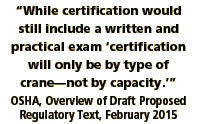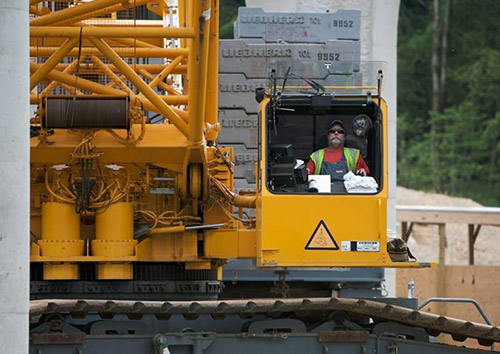August 2017—OSHA’s announcement last month that it was seeking a further one-year extension of the enforcement of its crane operator certification requirement may have surprised some and disappointed many, but the silver lining to this latest delay is that it provides an additional breathing space to allow the Agency to fix language in the rule that the industry has complained about for so long.
 The language in question of course revolves around whether operator certification should be according to the capacity of the crane as well as its type, and whether an employer has additional responsibilities for ensuring his or her operators are qualified beyond certifying them.
The language in question of course revolves around whether operator certification should be according to the capacity of the crane as well as its type, and whether an employer has additional responsibilities for ensuring his or her operators are qualified beyond certifying them.
NCCCO’s position, in alignment with the overwhelming majority of the industry that has commented on these two aspects, has always been “no” to the first question and “yes” to the second. And when OSHA last went on the record on the subject they were also in agreement. In its official document, Overview of Draft Proposed Regulatory Text for Crane Operator Qualification, published in February 2015, OSHA wrote that while certification would still include a written and practical exam “certification will only be by type of crane—not by capacity.”
In that same document, OSHA noted that, in addition to being certified, crane operators would also have to be evaluated on the same make and model of crane they plan to operate. It was when OSHA got into the details of how they wanted the employer (or his/her representative) to actually carry this out in practice that things went awry. Industry representatives at the March 2015 meeting of the Advisory Committee on Safety and Health (ACCSH), at which OSHA unveiled its proposal, pushed back hard, as did ACCSH itself, roundly condemning the proposal as financially burdensome and, in essence, simply impractical.
 Operators and employers alike are wondering if the additional year OSHA is requesting will really lead to publication of a revised final rule on operator certification before proposed new deadline of November 2018.
Operators and employers alike are wondering if the additional year OSHA is requesting will really lead to publication of a revised final rule on operator certification before proposed new deadline of November 2018.
OSHA Had Completed Work
The frustrating part of this story (now approaching its seventh year as measured from the publication of the final rule in 2010) is that, by its own account, OSHA had completed its work on revising this language before the change in administration earlier this year brought all regulatory activity to a screeching halt.
 OSHA’s Directorate of Construction consistently affirmed over the three months prior to the inauguration that, essentially, the proposed rule containing the new language was complete and was simply awaiting passage to the Office of Management and Budget (OMB) for its mandatory review.
OSHA’s Directorate of Construction consistently affirmed over the three months prior to the inauguration that, essentially, the proposed rule containing the new language was complete and was simply awaiting passage to the Office of Management and Budget (OMB) for its mandatory review.
That never happened and, with the November deadline marking the expiration of the three-year extension fast approaching, OSHA had little option but to seek a further delay.
In the interim, of course, employers are still required to ensure their operators are trained and competent to operate their cranes safely.
As this issue of ACT went to press, the industry was still awaiting the proposed rule that will extend the deadline. During that additional 12-month period, OSHA’s task will be to publish the proposed rule that will fix the offending language and, ultimately, to publish a final rule confirming the revised operator certification requirement. OSHA had three years to accomplish that task and failed. The question on everyone’s lips now is: Will another year really make any difference?
For additional history on OSHA’s Crane Rule, see NCCCO’s OSHA Crane Rule Resource Center.